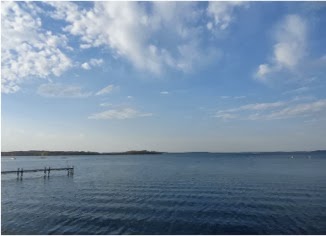Fresh water lineages of an abundant marine microbe have a distinctly divergent history.
The Science:

Lake Mendota, in Madison, Wis., is one of three lakes from which isolates of the SAR11 clade were collected. Image via Wikimedia Commons
Researchers assembled genomes from several single-cell isolates of the SAR11 group of Alphaproteobacteria and found that they form microclusters within the freshwater clade. They are also much less genetically diverse than the marine clades of SAR11, although they retain highly variable regions (HVR) of DNA that researchers believe help SAR11 bacteria evade viral infection.
The Impact:
Researchers are only beginning to understand the successful strategies that the SAR11 group of bacteria uses to survive in nearly every kind of ocean environment. They feed on organic carbon and release carbon dioxide in the process. Because there are so many of them – they make up an estimated half of all marine surface microbes – they exert a large influence on the global carbon cycle. These are the first genomes sequenced for the freshwater clades of this bacterial group. The surprising lack of genetic diversity in this clade provides a useful comparison for the highly diverse marine clades.
Summary
As the most abundant bacteria in oceans, researchers suspect SAR11 bacteria play an important role in the global carbon cycle, but their role isn’t well understood. One branch, or clade, of the SAR11 family grows in fresh water. This clade, called LD12, is difficult to study because researchers can’t cultivate it in the lab. As reported in a paper published November 28 2013 in the journal Genome Biology, a team of Swedish, German and American researchers sequenced the genomes of 10 isolates of LD12 bacteria gathered at three lakes (Mendota and Sparkling Lakes in Wisconsin and Damariscotta Lake in Maine). The team also took metagenome (microbial community) samples from all three lakes as well as three lakes in Sweden to complement the single-genome analysis. The single-cell genome sequences were generated at the DOE Joint Genome Institute.
They found that these isolates formed three microclusters, closely related groupings within the clade. They were surprised to find that unlike marine SAR11 bacteria, the freshwater bacteria were much less genetically diverse, when measured based on the ratio of recombination (genetic changes due to genes swapped with other bacteria) to mutation (genetic changes due to mistakes in DNA replication) in their genes.
The team suggests this is because LD12 bacteria probably had thinned out populations in their newly adapted environments (population bottlenecks) that reduced their genetic diversity. The physical boundaries of lakes may also have acted as barriers keeping LD12 populations from swapping genes with other SAR11 bacteria. But LD12 bacteria did retain hypervariable regions that are abundant in the genomes of marine SAR11 clades. Researchers believe these hypervariable regions help SAR11 bacteria vary their surface proteins and evade pelagiphages – recently discovered viruses that infect and kill SAR11 bacteria – and other pathogens and predators.
Contact
Tanja Woyke
Joint Genome Institute
[email protected]
Publication
Zaremba-Niedzwiedzka K et al. Single-cell genomics reveal low recombination frequencies in freshwater bacteria of the SAR11 clade. Genome Biology 2013, 14:R130
doi: 10.1186/gb-2013-14-11-r130
Funding
Department of Energy, Office of Science
National Science Foundation
Swedish Research Council
European Union
Goran Gustafsson Foundation
Knut and Alice Walenberg Foundation